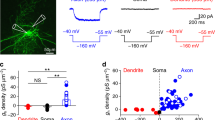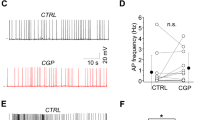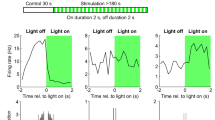Abstract
Networks of GABAergic interneurons are implicated in synchronizing cortical activity at gamma frequencies (30–70 Hz). Here we demonstrate that the combined electrical and GABAergic synaptic coupling of basket cells instantaneously entrained gamma-frequency postsynaptic firing in layers 2/3 of rat somatosensory cortex. This entrainment was mediated by rapid curtailment of gap junctional coupling potentials by GABAA receptor-mediated IPSPs. Electron microscopy revealed spatial proximity of gap junctions and GABAergic synapses on somata and dendrites. Electrical coupling alone entrained postsynaptic firing with a phase lag, whereas unitary GABAergic connections were ineffective in gamma-frequency phasing. These observations demonstrate precise spatiotemporal mechanisms underlying action potential timing in oscillating interneuronal networks.
This is a preview of subscription content, access via your institution
Access options
Subscribe to this journal
Receive 12 print issues and online access
$209.00 per year
only $17.42 per issue
Buy this article
- Purchase on Springer Link
- Instant access to full article PDF
Prices may be subject to local taxes which are calculated during checkout





Similar content being viewed by others
References
Niedermeyer, E. & Lopes da Silva, F. Electroencephalography: Basic Principles, Clinical Applications and Related Fields (Williams and Wilkins, Baltimore, 1993).
Jefferys, J. G. R., Traub, R. D. & Whittington, M. A. Neuronal networks for induced ‘40 Hz’ rhythms. Trends Neurosci. 19, 202– 208 (1996).
Mainen, Z. F. & Sejnowski, T. J. Reliability of spike timing in neocortical neurons. Science 268, 1503 –1506 (1995).
Singer, W. & Gray, C. M. Visual feature integration and the temporal correlation hypothesis. Annu. Rev. Neurosci. 18, 555–586 (1995).
Lisman, J. E. & Idiart, M. A. P. Storage of 7 +/− 2 short-term memories in oscillatory subcycles. Science 267, 1512–1515 (1995).
Singer, W. Neuronal synchrony: a versatile code for the definition of relations? Neuron 24, 49–65 ( 1999).
Buzsaki, G. & Chrobak, J. J. Temporal structure in spatially organized neuronal ensembles: a role for interneuronal networks. Current Neurobiol. 5, 504–510 (1995).
Csicsvari, J., Hirase, H., Czurko, A., Mamiya, A. & Buzsaki, G. Oscillatory coupling of hippocampal pyramidal cells and interneurons in the behaving rat. J. Neurosci. 19, 274–287 (1999).
Cobb, S. R., Buhl, E. H., Halasy, K., Paulsen, O. & Somogyi, P. Synchronization of neuronal activity in hippocampus by individual GABAergic interneurons. Nature 378, 75–78 (1995).
Traub, R. D., Whittington, M. A., Stanford, I. M. & Jefferys, J. G. R. A mechanism for generation of long-range synchronous fast oscillations in the cortex. Nature 383, 621– 624 (1996).
Ylinen, A. et al. Intracellular correlates of hippocampal theta rhythm in identified pyramidal cells, granule cells, and basket cells. Hippocampus 5, 78–90 (1995).
Lytton, W. W. & Sejnowski, T. J. Simulations of cortical pyramidal neurons synchronized by inhibitory interneurons. J. Neurophysiol. 66, 1059–1079 ( 1991).
Swadlow, H. A., Beloozerova, I. N. & Sirota, M. G. Sharp, local synchrony among putative feed-forward inhibitory interneurons of rabbit somatosensory cortex. J. Neurophysiol. 79, 567–582 ( 1998).
Buhl, E. H., Tamas, G. & Fisahn, A. Cholinergic activation and tonic excitation induce persistent gamma oscillations in mouse somatosensory cortex in vitro. J. Physiol. (Lond.) 513, 117–126 ( 1998).
Fisahn, A., Pike, F. G., Buhl, E. H. & Paulsen, O. Cholinergic induction of network oscillations at 40 Hz in the hippocampus in vitro. Nature 394, 186–189 ( 1998).
Whittington, M. A., Traub, R. D. & Jefferys, J. G. R. Synchronized oscillations in interneuron networks driven by metabotropic glutamate receptor activation. Nature 373, 612–615 (1995).
Christie, M. J., Williams, J. T. & North, R. A. Electrical coupling synchronizes subthreshold activity in locus coeruleus neurons in vitro from neonatal rats. J. Neurosci. 9, 3584–3589 ( 1989).
Mann-Metzer, P. & Yarom, Y. Electrotonic coupling interacts with intrinsic properties to generate synchronized activity in cerebellar networks of inhibitory interneurons. J. Neurosci. 19 , 3298–3306 (1999).
Draguhn, A., Traub, R. D., Schmitz, D. & Jefferys, J. G. Electrical coupling underlies high-frequency oscillations in the hippocampus in vitro. Nature 394, 189– 192 (1998).
Koos, T. & Tepper, J. M. Inhibitory control of neostriatal projection neurons by GABAergic interneurons. Nat. Neurosci. 2, 467–472 (1999).
Gibson, J. F., Beierlein, M. & Connors, B. W. Two networks of electrically coupled inhibitory neurons in neocortex. Nature 402, 75– 79 (1999).
Galarreta, M. & Hestrin, S. A network of fast-spiking cells in the neocortex connected by electrical synapses. Nature 402, 72–75 (1999).
Sloper, J. J. Gap junctions between dendrites in the primate neocortex. Brain. Res. 44, 641–646 ( 1972).
Peters, A. Morphological correlates of epilepsy: cells in the cerebral cortex. Adv. Neurol. 27, 21–48 ( 1980).
Kosaka, T. & Hama, K. Gap junctions between non-pyramidal cell dendrites in the rat hippocampus (CA1 and CA3 regions): a combined Golgi-electron microscopy study. J. Comp. Neurol. 231, 150–161 (1985).
Pappas, G. D. & Bennett, M. V. Specialized junctions involved in electrical transmission between neurons. Ann. NY Acad. Sci. 137, 495–508 ( 1966).
Nakajima, Y. Fine structure of the synaptic endings on the Mauthner cell of the goldfish. J. Comp. Neurol. 156, 375– 402 (1974).
Tamas, G., Somogyi, P. & Buhl, E. H. Differentially interconnected networks of GABAergic interneurons in the visual cortex of the cat. J. Neurosci. 18, 4255–4270 (1998).
Reyes, A. et al. Target-cell-specific facilitation and depression in neocortical circuits. Nat. Neurosci. 1, 279– 285 (1998).
Tamas, G., Buhl, E. H. & Somogyi, P. Fast IPSPs elicited via multiple synaptic release sites by distinct types of GABAergic neuron in the cat visual cortex. J. Physiol. (Lond.) 500, 715–738 (1997).
Buhl, E. H., Halasy, K. & Somogyi, P. Diverse sources of hippocampal unitary inhibitory postsynaptic potentials and the number of synaptic release sites. Nature 368, 823–828 (1994).
Peinado, A., Yuste, R. & Katz, L. C. Extensive dye coupling between rat neocortical neurons during the period of circuit formation. Neuron 10, 103–114 (1993).
Connors, B. W., Benardo, L. S. & Prince, D. A. Coupling between neurons of the developing rat neocortex. J. Neurosci. 3, 773–782 (1983).
Tamas, G., Buhl, E. H. & Somogyi, P. Massive autaptic self-innervation of GABAergic neurons in cat visual cortex. J. Neurosci. 17, 6352 –6364 (1997).
Ward, J. H. Hierarchical grouping to optimize an objective function. J. Am. Stat. Assoc. 58, 236 (1963).
Acknowledgements
We thank N. Kogo, G. Maccaferri and O. Paulsen for scientific advice and technical help and J. D. B. Roberts and P. Jays for technical assistance. This work was also supported by the James S. McDonnell Foundation (EESI grant No 97-39), the Wellcome Trust, a European Commission Shared Cost RTD Program (No. BIO4CT96-0585) and the Hungarian Scientific Research Fund. G. T. was a Zoltán Magyary and OTKA Scholar during part of this project.
Author information
Authors and Affiliations
Corresponding author
Rights and permissions
About this article
Cite this article
Tamás, G., Buhl, E., Lörincz, A. et al. Proximally targeted GABAergic synapses and gap junctions synchronize cortical interneurons. Nat Neurosci 3, 366–371 (2000). https://doi.org/10.1038/73936
Received:
Accepted:
Issue Date:
DOI: https://doi.org/10.1038/73936
This article is cited by
-
Thalamic and prefrontal GABA concentrations but not GABAA receptor densities are altered in high-functioning adults with autism spectrum disorder
Molecular Psychiatry (2021)
-
Portrait of visual cortical circuits for generating neural oscillation dynamics
Cognitive Neurodynamics (2021)
-
Coherence and cognition in the cortex: the fundamental role of parvalbumin, myelin, and the perineuronal net
Brain Structure and Function (2021)
-
A computational investigation of electrotonic coupling between pyramidal cells in the cortex
Journal of Computational Neuroscience (2020)
-
Challenging the point neuron dogma: FS basket cells as 2-stage nonlinear integrators
Nature Communications (2019)



